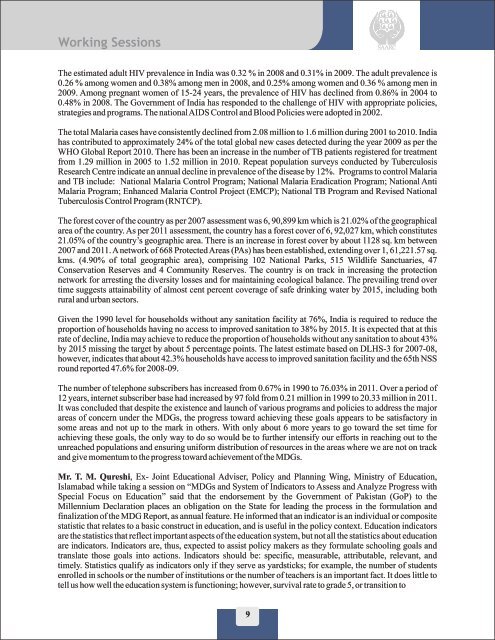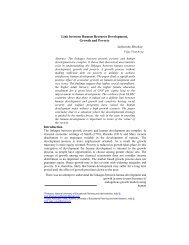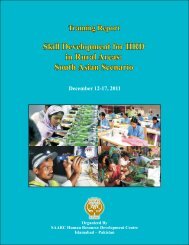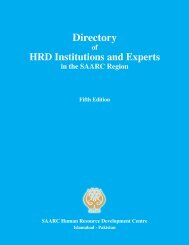Training Report: Millennium Development Goals in the SAARC Region
Training Report: Millennium Development Goals in the SAARC Region
Training Report: Millennium Development Goals in the SAARC Region
You also want an ePaper? Increase the reach of your titles
YUMPU automatically turns print PDFs into web optimized ePapers that Google loves.
Work<strong>in</strong>g Sessions<br />
The estimated adult HIV prevalence <strong>in</strong> India was 0.32 % <strong>in</strong> 2008 and 0.31% <strong>in</strong> 2009. The adult prevalence is<br />
0.26 % among women and 0.38% among men <strong>in</strong> 2008, and 0.25% among women and 0.36 % among men <strong>in</strong><br />
2009. Among pregnant women of 15-24 years, <strong>the</strong> prevalence of HIV has decl<strong>in</strong>ed from 0.86% <strong>in</strong> 2004 to<br />
0.48% <strong>in</strong> 2008. The Government of India has responded to <strong>the</strong> challenge of HIV with appropriate policies,<br />
strategies and programs. The national AIDS Control and Blood Policies were adopted <strong>in</strong> 2002.<br />
The total Malaria cases have consistently decl<strong>in</strong>ed from 2.08 million to 1.6 million dur<strong>in</strong>g 2001 to 2010. India<br />
has contributed to approximately 24% of <strong>the</strong> total global new cases detected dur<strong>in</strong>g <strong>the</strong> year 2009 as per <strong>the</strong><br />
WHO Global <strong>Report</strong> 2010. There has been an <strong>in</strong>crease <strong>in</strong> <strong>the</strong> number of TB patients registered for treatment<br />
from 1.29 million <strong>in</strong> 2005 to 1.52 million <strong>in</strong> 2010. Repeat population surveys conducted by Tuberculosis<br />
Research Centre <strong>in</strong>dicate an annual decl<strong>in</strong>e <strong>in</strong> prevalence of <strong>the</strong> disease by 12%. Programs to control Malaria<br />
and TB <strong>in</strong>clude: National Malaria Control Program; National Malaria Eradication Program; National Anti<br />
Malaria Program; Enhanced Malaria Control Project (EMCP); National TB Program and Revised National<br />
Tuberculosis Control Program (RNTCP).<br />
The forest cover of <strong>the</strong> country as per 2007 assessment was 6, 90,899 km which is 21.02% of <strong>the</strong> geographical<br />
area of <strong>the</strong> country. As per 2011 assessment, <strong>the</strong> country has a forest cover of 6, 92,027 km, which constitutes<br />
21.05% of <strong>the</strong> country’s geographic area. There is an <strong>in</strong>crease <strong>in</strong> forest cover by about 1128 sq. km between<br />
2007 and 2011. A network of 668 Protected Areas (PAs) has been established, extend<strong>in</strong>g over 1, 61,221.57 sq.<br />
kms. (4.90% of total geographic area), compris<strong>in</strong>g 102 National Parks, 515 Wildlife Sanctuaries, 47<br />
Conservation Reserves and 4 Community Reserves. The country is on track <strong>in</strong> <strong>in</strong>creas<strong>in</strong>g <strong>the</strong> protection<br />
network for arrest<strong>in</strong>g <strong>the</strong> diversity losses and for ma<strong>in</strong>ta<strong>in</strong><strong>in</strong>g ecological balance. The prevail<strong>in</strong>g trend over<br />
time suggests atta<strong>in</strong>ability of almost cent percent coverage of safe dr<strong>in</strong>k<strong>in</strong>g water by 2015, <strong>in</strong>clud<strong>in</strong>g both<br />
rural and urban sectors.<br />
Given <strong>the</strong> 1990 level for households without any sanitation facility at 76%, India is required to reduce <strong>the</strong><br />
proportion of households hav<strong>in</strong>g no access to improved sanitation to 38% by 2015. It is expected that at this<br />
rate of decl<strong>in</strong>e, India may achieve to reduce <strong>the</strong> proportion of households without any sanitation to about 43%<br />
by 2015 miss<strong>in</strong>g <strong>the</strong> target by about 5 percentage po<strong>in</strong>ts. The latest estimate based on DLHS-3 for 2007-08,<br />
however, <strong>in</strong>dicates that about 42.3% households have access to improved sanitation facility and <strong>the</strong> 65th NSS<br />
round reported 47.6% for 2008-09.<br />
The number of telephone subscribers has <strong>in</strong>creased from 0.67% <strong>in</strong> 1990 to 76.03% <strong>in</strong> 2011. Over a period of<br />
12 years, <strong>in</strong>ternet subscriber base had <strong>in</strong>creased by 97 fold from 0.21 million <strong>in</strong> 1999 to 20.33 million <strong>in</strong> 2011.<br />
It was concluded that despite <strong>the</strong> existence and launch of various programs and policies to address <strong>the</strong> major<br />
areas of concern under <strong>the</strong> MDGs, <strong>the</strong> progress toward achiev<strong>in</strong>g <strong>the</strong>se goals appears to be satisfactory <strong>in</strong><br />
some areas and not up to <strong>the</strong> mark <strong>in</strong> o<strong>the</strong>rs. With only about 6 more years to go toward <strong>the</strong> set time for<br />
achiev<strong>in</strong>g <strong>the</strong>se goals, <strong>the</strong> only way to do so would be to fur<strong>the</strong>r <strong>in</strong>tensify our efforts <strong>in</strong> reach<strong>in</strong>g out to <strong>the</strong><br />
unreached populations and ensur<strong>in</strong>g uniform distribution of resources <strong>in</strong> <strong>the</strong> areas where we are not on track<br />
and give momentum to <strong>the</strong> progress toward achievement of <strong>the</strong> MDGs.<br />
Mr. T. M. Qureshi, Ex- Jo<strong>in</strong>t Educational Adviser, Policy and Plann<strong>in</strong>g W<strong>in</strong>g, M<strong>in</strong>istry of Education,<br />
Islamabad while tak<strong>in</strong>g a session on “MDGs and System of Indicators to Assess and Analyze Progress with<br />
Special Focus on Education” said that <strong>the</strong> endorsement by <strong>the</strong> Government of Pakistan (GoP) to <strong>the</strong><br />
<strong>Millennium</strong> Declaration places an obligation on <strong>the</strong> State for lead<strong>in</strong>g <strong>the</strong> process <strong>in</strong> <strong>the</strong> formulation and<br />
f<strong>in</strong>alization of <strong>the</strong> MDG <strong>Report</strong>, as annual feature. He <strong>in</strong>formed that an <strong>in</strong>dicator is an <strong>in</strong>dividual or composite<br />
statistic that relates to a basic construct <strong>in</strong> education, and is useful <strong>in</strong> <strong>the</strong> policy context. Education <strong>in</strong>dicators<br />
are <strong>the</strong> statistics that reflect important aspects of <strong>the</strong> education system, but not all <strong>the</strong> statistics about education<br />
are <strong>in</strong>dicators. Indicators are, thus, expected to assist policy makers as <strong>the</strong>y formulate school<strong>in</strong>g goals and<br />
translate those goals <strong>in</strong>to actions. Indicators should be: specific, measurable, attributable, relevant, and<br />
timely. Statistics qualify as <strong>in</strong>dicators only if <strong>the</strong>y serve as yardsticks; for example, <strong>the</strong> number of students<br />
enrolled <strong>in</strong> schools or <strong>the</strong> number of <strong>in</strong>stitutions or <strong>the</strong> number of teachers is an important fact. It does little to<br />
tell us how well <strong>the</strong> education system is function<strong>in</strong>g; however, survival rate to grade 5, or transition to<br />
9
















